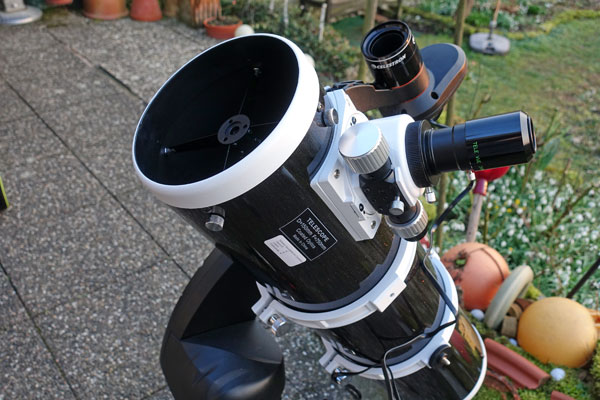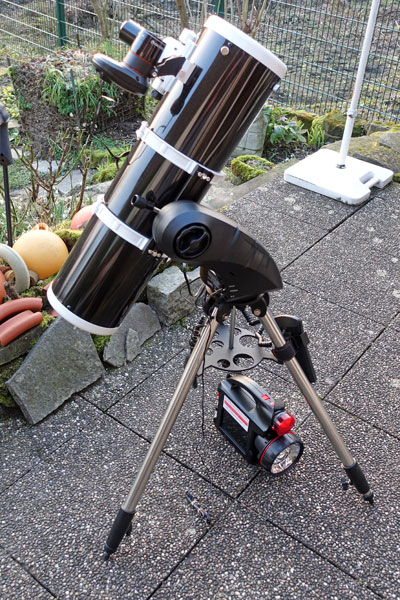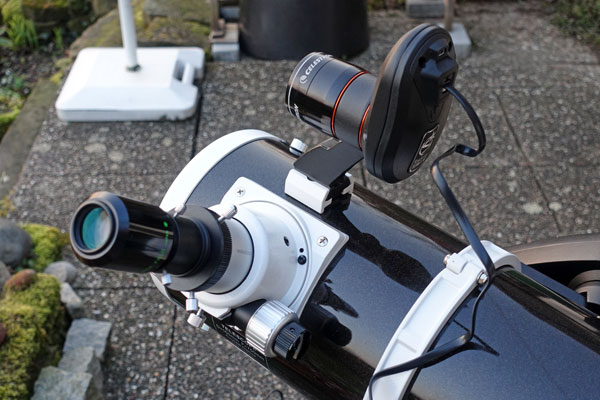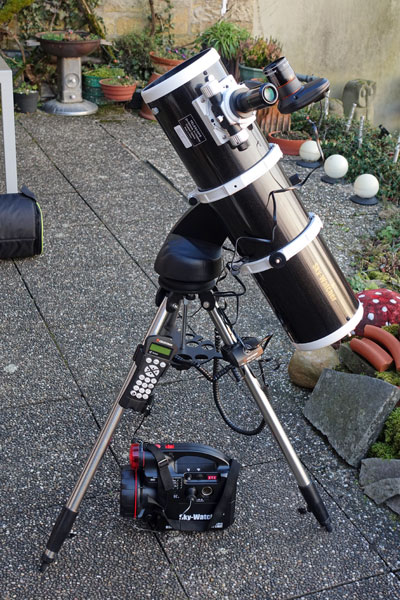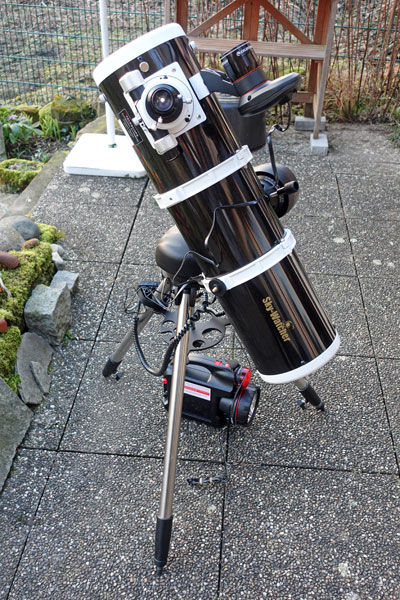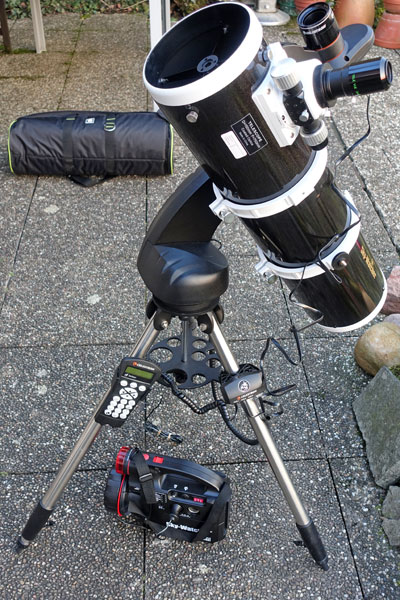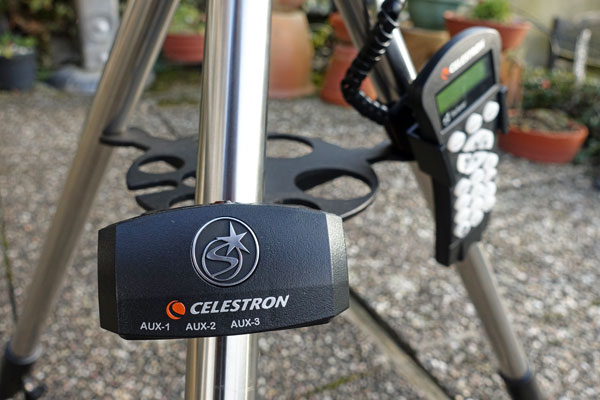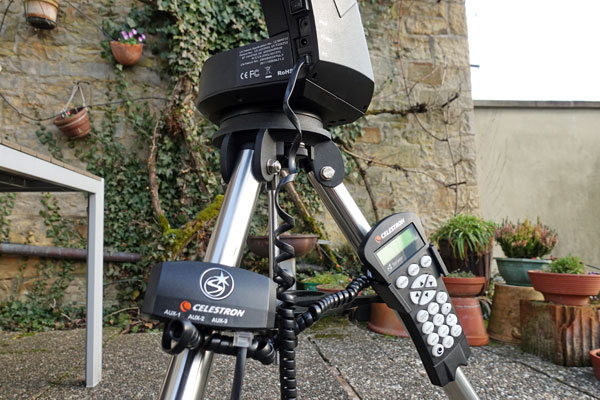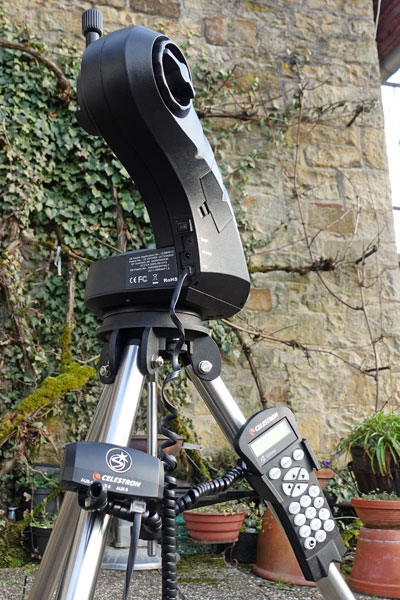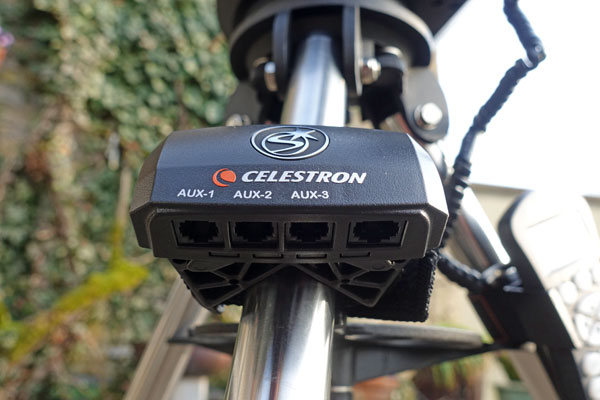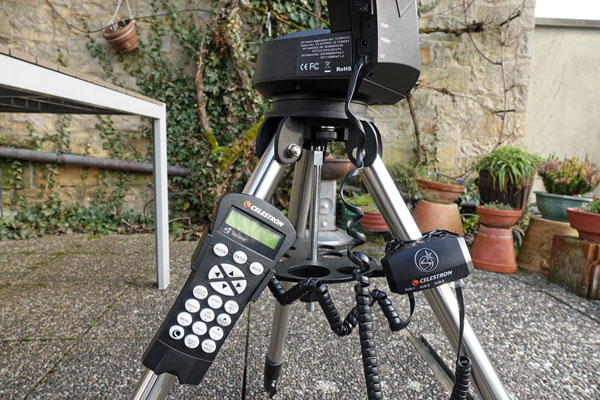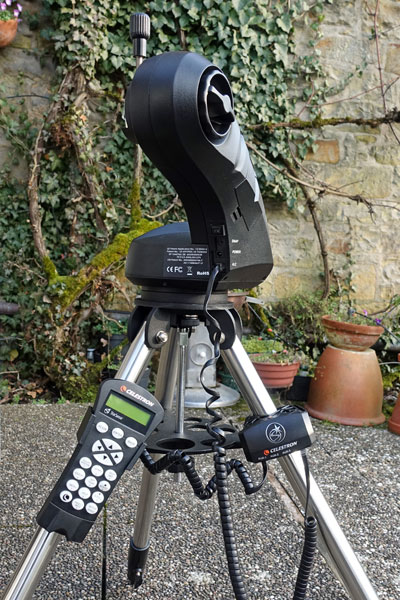Celestron StarSense AutoAlign for Sky-Watcher - Further Experiences
Introduction | Increasing Positioning Accuracy | Avoiding Cable Wrap | User Profiles | Freedom Find Bye-Bye? | Hand Control Cable | Preliminary Conclusions | Links
Archive
On this page, I collect further experiences with and some information about my Celestron StarSense AutoAlign for Sky-Watcher module*, which I will call "StarSense module" for short in the following.
*) Ordered on February 1, from Teleskop-Spezialisten, arrived on February 7, 2018, sold in mid-November 2022.
On this page, I want to investigate, how I can increase the positioning accuracy, avoid cable wrap, and discuss user profiles, Freedom Find, and the hand control cable.
| Note: In mid-November 2022, I sold my Celestron StarSense AutoAlign for Sky-Watcher module. I therefore can no longer report any experiences with the StarSense module here. |
See also:
- Celestron StarSense AutoAlign for Sky-Watcher Information Archive
- Celestron StarSense AutoAlign for Sky-Watcher - First Experiences Archive
- Celestron StarSense AutoAlign for Sky-Watcher - Further Experiences Archive
- Celestron StarSense AutoAlign for Sky-Watcher - Connecting to a Mac (USB) Archive
- Celestron StarSense AutoAlign for Sky-Watcher - Using it with a Celestron C8 Archive
- Sky-Watcher AZ GoTo Mounts (Star Discovery, AZ-GTi) - Instructions Archive
Introduction
When I bought the StarSense module I had two main expectations:
- That the alignment procedure would be simplified. This means above all that I would no longer be confronted with "unknown alignment stars"* and that I no longer have to crawl "below" the mount to align stars using the red-dot finder.
- That the accuracy of positioning would improve compared with manual
two-star alignment:
- On the one hand, the Star Discovery mount was never really "level" when I used it, and this should not matter to the StarSense module.
- On the other hand, my Astronomy dealer told me that the accuracy of the alignment would be higher when using the StarSense module. However, I have also read in test reports that one should not expect too much with repsect to the accuracy of the StarSense alignment...
*) I am not completely unwilling to learn in this respect and created a list of alignment stars as well as printed out a corresponding map (see page Sky-Watcher Star Discovery AZ GoTo-Mount - Named and Alignment Stars). But when you are a bit under time pressure and the hand box confronts you with stars, of which you have no idea where they are located in the sky, this is quite an unpleasant situation (of course, you can go to the computer and have the star shown to you, but this takes time...). Now that I prepared the list, this should go faster...
With respect to the first item, I can tell at least so much: Once one has mastered the initial hurdles, then the "creep under the scope problem" is a thing of the past.
The second item is a little more complicated: First of all, the alignment has to be successful before you can talk about improvements in accuracy. And unfortunately, the automatic alignment fails for me more often than I had expected. In the case that the automatic alignment is successful, it can still happen that the accuracy of the positioning leaves a lot to be desired. To my knowledge, the following can then be done in this case:
- Either you start a new automatic alignment,
- Try a manual alignment, or
- Use one of the methods described in the manual to increase the accuracy
of the alignment (which can, of course, be done right from the start):
- Add additional alignment points (10 at maximum)
- SYNC (Synchronization)
- HELP function
And if nothing helps, a new calibration is necessary...
In the following, I would like to discuss these methods briefly, as far as I am already able to write something about them...
Photos: StarSense on Explorer 150PDS and Star Discovery AZ GoTo mount
Increasing Positioning Accuracy
Repeat Automatic Alignment
The first thing to do if the alignment fails or is insufficient is certainly to repeat the automatic alignment, especially if it was perhaps still too bright for the alignment. Sometimes, however, I have already experienced that things got worse and worse, and that the automatic alignment became more and more "misaligned".
If I want to align automatically again or align manually, I always switch the mount off and on again first, because I have experienced so far that the mount aligned "somewhere" when it was aligned another time without switching it off (unfortunately, I then also have to reactivate "Cordwrap"...). Maybe someone will write me what my mistake is...
Manual Alignment
The manual alignment is especially intended and suitable for the case that parts of the sky are covered. According to the manual, the positioning is less accurate than with automatic alignment, but quite good for the part of the sky for which the alignment was done. So you should only observe in that sky region.
I have only performed the manual alignment for a few times. I therefore cannot tell whether the accuracy of the alignment is better for me than for the automatic alignment (I cannot see the whole sky).
Adding Additional Alignment (Reference) Points
I added additional alignment points only once up to now, and was not able to see any positive effects of this (I approached the same target after each new reference point and checked its position in the viewfinder). Nevertheless, this method should have a positive effect. The manual points out that additional reference points improve the GoTo model, even in the case of deflections or other mechanical sources of error.
SYNC (Synchronization)
When you synchronize to a star, the GoTo model is re-aligned to that star, which improves the accuracy in the vicinity of it. Since you cannot undo synchronization to the star with StarSense (if you want to change the sky position), Michael Swanson advises against using this feature in his NexStar book and advises using additional reference points instead.
The manual also suggests the use of this function in the event that you hit the telescope or that an axle clamp has loosened.
HELP Button
According to the manual, the HELP button is intended to improve the positioning accuracy if bright targets cannot be positioned in the eyepiece or can only be positioned poorly. This should be applicable especially for manual alignment.
My own experiments with this function did not yield any results, and Michael Swanson does not mention this function in his book at all...
Repeat Calibration
If nothing helps, a new calibration seems to me to be the "ultima ratio" for me, especially since one cannot (or I cannot...) check whether the calibration is still OK. I did not recalibrate my module until August 2021, when I prepared the StarSense module for using it whith my Celestron C8.
Recap
At the moment, this list is a compilation of possibilities in order to keep them in mind. I have not been able to report on practical experiences so far. After all, I already know that I should better do without the SYNC function - and perhaps also without the HELP function...
Avoiding Cable Wrap
|
StarSense relay box |
StarSense relay box and handbox at the mount |
Ditto |
|
StarSense relay box, seen more from below |
StarSense relay box and handbox at the mount - positions exchanged for less cable clutter |
Ditto |
Photos: StarSense at Explorer 150PDS and Star Discovery AZ GoTo mount
If you mount the StarSense module on the telescope, which in turn sits on a mount, then you have to connect some devices with cables:
- StarSense module with relay box
- Relay box with handbox
- Relay box with mount (8-pins at the relay box)
- Mounting with power supply
When an automatic alignment is started, the telescope may rotate once around its own axis during the alignment procedure and begin to "wind up" some of the connecting cables. Considering their limited length, this, of course, quickly gets to its limits! And if you approach certain targets after the alignment, it can happen that the situation worsens. I have often been on the verge of disconnecting and reconnecting the plugs of cables, but you are certainly losing your alignment when you do so. So I refrained from doing so and tried to pull the cables a little by hand. Fortunately, it has not yet happened to me that the mount's movement was stopped by the cable during alignment or GoTo movements...
Overall, however, this situation is unsatisfactory. And it does not seem to have completely escaped Celestron either, because there is a "Cordwrap" function somewhere buries in the handbox menu, which is supposed to prevent the wrapping of cables. In the English manual, this functio is shown in the "menu tree" at "Menu > StarSense Manual > Cordwrap", but with my equipment it is "Menu > Telescope > Cordwrap." The function is, of course, not documented, and in my German manual it is completely missing (in some English manuals this function does not appear either)...
I called this function once and did not understand the instructions given by the handbox. That is why I had not used it until then. At the beginning of April 2018, I finally searched the Internet for this function and found the following hints in a Cloudy Nights discussion given by Michael Swanson, who also wrote the book The NexStar User's Guide II (already in the second edition) on Celestron telescopes.
Cordwrap: Michael Swanson (link) - from my book):
- Press MENU, select Telescope, scroll to Cordwrap and press ENTER. The hand control will then display the current setting.
- Use the scroll buttons to change the setting.
- When changing to On, the hand control will then prompt you to position
the ‘scope at the center of the range of motion, which will be opposite
the no-cross line.
- Generally, the celestial pole is the best no-cross line when mounted alt-az (no wedge), so for those in the Northern Hemisphere, point the ‘scope to the south.
- For those in the Southern Hemisphere, point the ‘scope to the north.
- When mounted on a wedge, the best no-cross line is downward, so point the ‘scope up at the meridian.
- Press ENTER to complete.
Now I at least understand the instructions that the hand box gives me. I ordered the book and hope to learn a little more from it and that the StarSense chapter justifies the almost 30 EUR...
In the meantime, I tried to follow the instructions for the Cordwrap function, but the results are not yet clear to me... When aligning automatically, the mount clearly exceeded the limit once. Perhaps the limit is not valid for the alignment...
Obviously you have to reactivate (set to On) the Cordwrap function every time the Starsense module (and the GoTo control) is switched on. I find this quite annoying, because so far I do not get the alignment right away, and I have to switch off the control to start a new alignment (otherwise the telescope points somewhere...).
I have also found a German and English manual for the Celestron SkyProdigy telescope, which describes the Cordwrap function as follows:
- Cordwrap – Cordwrap safeguards against the telescope slewing more than 360º in azimuth and wrapping cables around the base of the telescope. This is useful any time that the telescope is powered using an external power supply. By default, the cord wrap feature is turned on.
- There may be a time when the telescope may not slew to an object from the shortest distance but instead slew to the object from the opposite direction. This is normal and necessary to prevent power cord from wrapping around the telescope.
According to this text, this function would be activated by default, which is not the case with my StarSense module. It is also points out that the telescope sometimes has to travel long distances when this function is activated.
User Profiles
When I purchased the StarSense module, I hoped to be able to operate it on three different telescope tubes. This is theoretically possible, but every time I change the telescope tube, the module has to be recalibrated, which is quite arduous according to my astronomy dealer Mr. Kloß - he advised against this.
So I decided to use the StarSense module only with my Explorer 150PDS. At least, the module can, according to the manual, store and retrieve up to 10 different alignments, but the purpose of this feature is not evident to me, unless you have different fixed positions at which you operate the telescope. But my tripod stand always in somewhat different places or somewhere else, so what is the point of this feature? Maybe I will find out some day....
However, in a YouTube video and later in a discussion thread, I found that there are also user profiles available that seem to serve the exact purpose of using the module on different telescopes. This function is listed in the menu item "Hand Control," which, of course, it is not documented. And so far I was not able to find out anything more about this function. A seemingly "relevant" discussion thread in Stargazers Lounge, of course, quickly slipped into other directions, without providing much information...
Freedom Find Bye-Bye?
Many Sky-Watcher mounts can also be moved by hand without losing the alignment thanks to the "Freedom Find" technology. With the StarSense module, you obviously must not move anything with your hand (I tested the with pointing to stars). This is a pity, because the sensors provide the needed information, and it is actually the same company...
Hand Control Cable
The twisted cable of the manual control unit (hand control) is short and tight. And because it is so tight, it cannot be extended, even if there were some cable available. By the way, this bothers not only me, but also some YouTubers...
Add to this the "ingenious" Sky-Watcher holder for the hand control, which already annoyed me when operating the original Sky-Watcher hand control: Every second time, the hand control falls out of the holder (which is attached to one tripod leg), because it is so awkward to put it into the holder in the dark. By daylight, I can, admittedly, put it in without hassle...
So I try to put the hand control somewhere... While I was able to put the Sky-Watcher hand control on the ground (where it can easily get scratches...) because the cable was longer (it is now used for other purposes by the StarSense module...), the Celestron hand control is now dangling diagonally in the air and lies with its top on the ground. In this situation, it swings back and forth and creates disturbing trembling when I take pictures with the Atik-Infinity camera...
The only thing that might help here is a sufficiently large sock hanging from the tripod leg for holding the hand control...
Preliminary Conclusions
This is just a collection of topics and more or less preliminary...
Links
- Celestron Website, USA: www.celestron.com
- Product page: www.celestron.com/products/starsense-autoalign (for Celestron only) - www.celestron.com/products/starsense-autoalign-for-sky-watcher-mounts (for Sky-Watcher)
- Celestron, Germany (Baader-Planetarium): www.celestron-deutschland.de
Product page: www.celestron-deutschland.de/product.php?CatID=31&ProdID=1147 (for Celestron only) - www.celestron-deutschland.de/product.php?CatID=31&ProdID=1362 (for Sky-Watcher) - Pages from German distributors for the Celestron StarSense for Sky-Watcher:
- Teleskop-Spezialisten (here the module was bought): www.teleskop-spezialisten.de/shop/Montierung-Zubehoer/Nachfuehrung-und-GoTo/Celestron-StarSense-fuer-GoTo-Montierungen-automatische-Eichung-Alignement::1914.html (for Celestron only, in German) - www.teleskop-spezialisten.de/shop/Mounts-Accessories//::1914.html?language=en (for Celestron only, in English) // www.teleskop-spezialisten.de/shop/Montierung-Zubehoer/Nachfuehrung-und-GoTo/Celestron-StarSense-AutoAlign-fuer-Skywatcher-Montierungen::2096.html?language=de (for Sky-Watcher, in German) - www.teleskop-spezialisten.de/shop/Mounts-Accessories//::2096.html (for Sky-Watcher, in English)
- Teleskop-Service/Express: www.teleskop-express.de/shop/product_info.php/language/en/info/p6040_Celestron-StarSense-fuer-GoTo-Montierungen---vollautomatische-Eichung.html (for Celestron ony, in English) - www.teleskop-express.de/shop/product_info.php/info/p9016_Celestron-StarSense-AutoAlign-for-Skywatcher-mounts.html (for Sky-Watcher, in English)
- Astroshop: www.astroshop.eu/controls-with-goto/celestron-starsense-module-including-hand-controller/p,32954 (for Celestron only, in English) - www.astroshop.eu/controls-with-goto/celestron-starsense-autoalign-for-skywatcher-synscan-mounts/p,51606 (for Sky-Watcher, in English)
- StarSense Start Up Problems (thread in Cloudy Nights, started by hamdul): www.cloudynights.com/topic/485630-starsense-start-up-problems
- How to Set Up StarSense AutoAlign (Celestron video on YouTube): www.youtube.com/watch?v=OqqoFZyxzQg
- Celestron StarSense 'User profiles'? (thread in Stargazers Lounge, started by GrampyG): stargazerslounge.com/topic/246401-celestron-starsense-user-profiles/
- A few StarSense Questions (thread in Cloudy Nights, started by GoFish => a.o. cordwrap): www.cloudynights.com/topic/612841-a-few-starsense-questions/
- Michael Swanson (2017). The NexStar User's Guide II. Springer. Softcover ISBN: 978-3-319-64932-0 (Link)
- See also my page offering Astronomy Links.
| 28.11.2024 |
